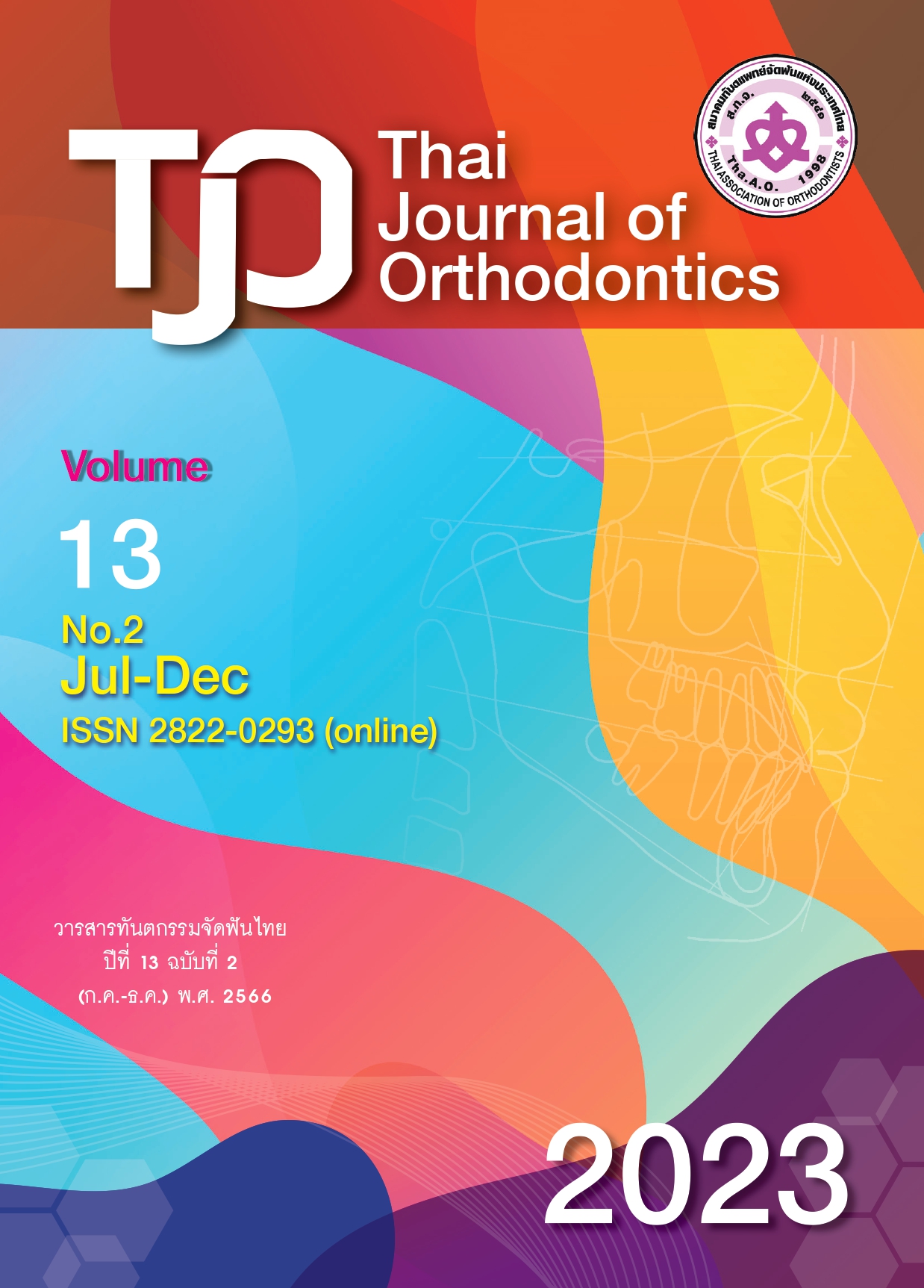PSU Intruder Technique to Intrude an Over-erupted Single Tooth: A Case Report
Main Article Content
Abstract
Most orthodontists are often challenged with single tooth over-eruption. The solution should focus only on specifically intruding the tooth and ensure it does not unexpectedly move the adjacent teeth. Various techniques of tooth intrusion are used mainly with an asymmetrical V-bend or temporary anchorage devices. These techniques clearly affect the adjacent teeth or result in soft tissue invasion.
This case report introduces an alternative single-tooth intrusion technique applied to the upper second molar. This technique is the so-called “PSU intruder technique that used a 0.016" × 0.022" beta titanium wire bent into a single helical loop with palatal positioned brackets. The patient in this case report had missing bilateral upper lateral incisors and the lower left first molar. Unfortunately, there was an interference at the palatal cusp of the upper left second molar during the finishing stage since this patient was treated during the growth stage. However, correct alignment of the upper left second molar was achieved with an acceptable occlusion, while the PSU intruder technique did not affect the adjacent teeth.
Article Details

This work is licensed under a Creative Commons Attribution-NonCommercial-NoDerivatives 4.0 International License.
References
Hwang S, Choi YJ, Lee JY, Chung C, Kim KH. Ectopic eruption of the maxillary second molar: predictive factors. Angle Orthod 2017;87(4):583-9.
Tanaka EM, Sato S. Longitudinal alteration of the occlusal plane and development of different dentoskeletal frames during growth. Am J Orthod Dentofacial Orthop 2008;134(5):602. e1-11.
Mulligan TF. Common sense mechanics. J Clin Orthod 1980;14(3):180-9.
Cao Y, Liu C, Wang C, Yang X, Duan P, Xu C. A simple way to intrude overerupted upper second molars with miniscrews. J Prosthodont 2013;22(8):597-602.
Cousley RR. A clinical strategy for maxillary molar intrusion using orthodontic mini-implants and a customized palatal arch. J Orthod 2010;37(3):202-8.
Park Y-C, Lee H-A, Choi N-C, Kim D-H. Open bite correction by Intrusion of posterior teeth with miniscrews. Angle Orthod 2008;78(4):699-710.
Sorathesn K. Craniofacial norm for Thai in combined orthodontic surgical procedure. J Dent Assoc Thai 1988;38(5):190-201.
Suchato W, Chaiwat J. Cephalometric evaluation of the dentofacial complex of Thai adults. J Dent Assoc Thai 1984;34(5):233-43.
Dechkunakron S, Chaiwat J, Sawaengkit P. Thai adult norms in various lateral cephalometric analysis. J Dent Assoc Thai 1994;44(5-6):202-14.
Alobeid A, Hasan M, Al-Suleiman M, El-Bialy T. Mechanical properties of cobalt-chromium wires compared to stainless steel and β-titanium wires. J Orthod Sci 2014;3(4):137-41.
Uribe F, Nanda R. Treatment of class II, division 2 malocclusion in adults: biomechanical considerations. J Clin Orthod 2003;37(11):599-606.
Levitan ME, Himel VT. Dens evaginatus: literature review, pathophysiology, and comprehensive treatment regimen. J Endod 2006;32(1):1-9.
King NM, Tsai JS, Wong H. Morphological and numerical characteristics of the southern Chinese dentitions. Part I: anomalies in the permanent dentition. Open Anthropol J 2010;3:54-64.
Bozga A, Stanciu RP, Mănuc D. A study of prevalence and distribution of tooth agenesis. J Med Life 2014;7(4):551-4.
Kokich VG. Maxillary lateral incisor implants: planning with the aid of orthodontics. J Oral Maxillofac Surg 2004;62(9 Suppl 2):48-56.
Kokich VG. Maxillary lateral incisor implants: planning with the aid of orthodontics. Tex Dent J 2007;124(4):388-98.
Zachrisson BU, Rosa M, Toreskog S. Congenitally missing maxillary lateral incisors: canine substitution. Am J Orthod Dentofacial Orthop 2011;139(4):434-45.
Blake M, Bibby K. Retention and stability: a review of the literature. Am J Orthod Dentofacial Orthop 1998;114(3):299-306.


